1996 CHEVROLET S10 display
[x] Cancel search: displayPage 124 of 375
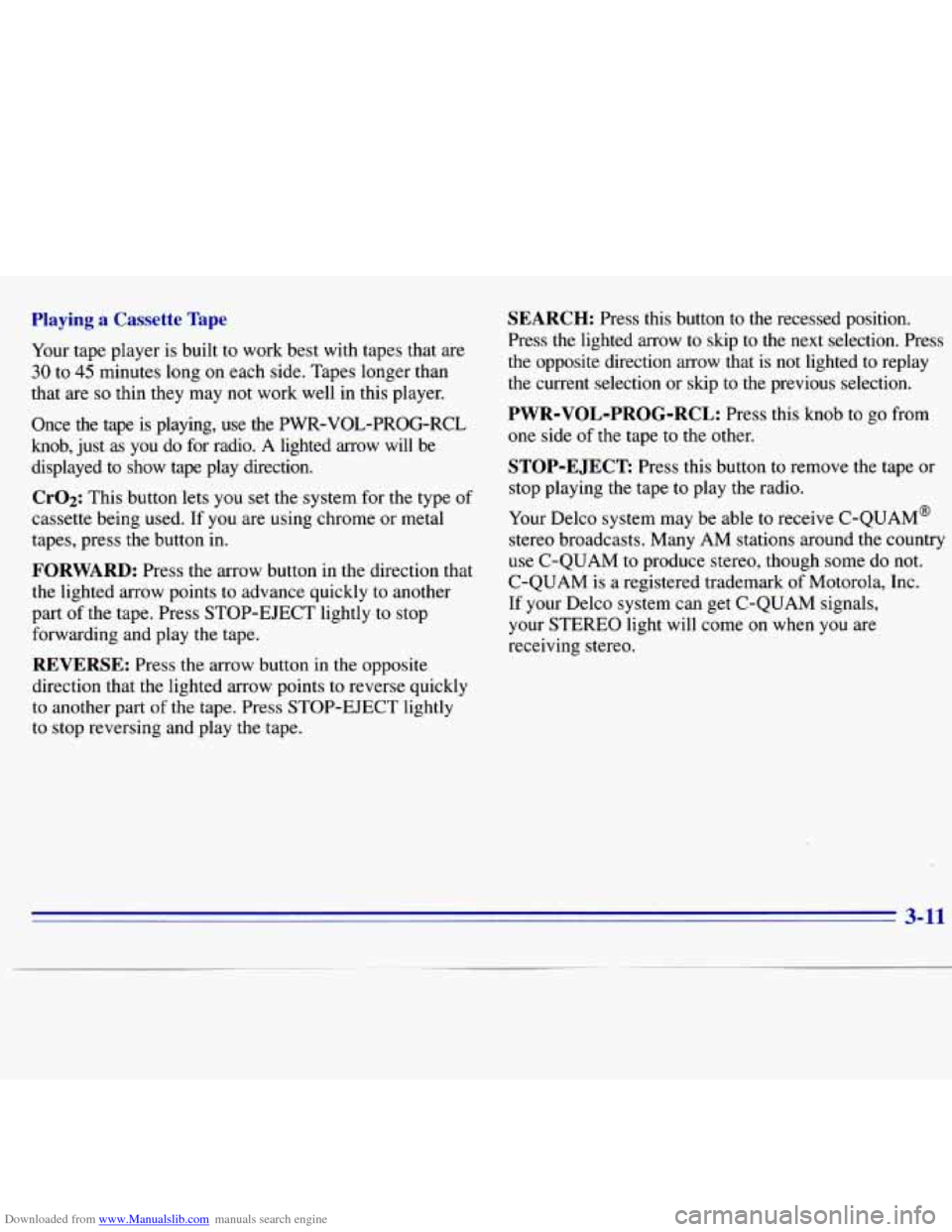
Downloaded from www.Manualslib.com manuals search engine Playing a Cassette Tape
Your tape player is built to work best with tapes that are
30 to 45 minutes long on each side. Tapes longer than
that are
so thin they may not work well in this player.
Once the
tape is playing, use the PWR-VOL-PROG-RCL
knob, just
as you do for radio. A lighted arrow will be
displayed to
show tape play direction.
Cr02: This button lets you set the system for the type of
cassette being used. If you are using chrome or metal
tapes, press the button in.
FORWARD: Press the arrow button in the direction that
the lighted arrow points to advance quickly to another
part of the tape. Press STOP-EJECT lightly to stop
forwarding and play the tape.
SEARCH: Press this button to the recessed position.
Press the lighted
arrow to skip to the next selection. Press
the opposite direction arrow that is not lighted to replay the current selection or skip to the previous selection.
PWR-VOL-PROG-RCL: Press this knob to go from
one side
of the tape to the other.
STOP-EJECT: Press this button to remove the tape or
stop playing the tape to play the radio.
Your Delco system may be able to receive C-QUAM@
stereo broadcasts. Many AM stations around the country
use C-QUAM to produce stereo, though some do not.
C-QUAM is a registered trademark of Motorola, Inc.
If your Delco system can get C-QUAM signals,
your STEREO light
will come on when you are
receiving stereo.
REVERSE: Press the arrow button in the opposite
direction that the lighted arrow points to reverse quickly
to another part of the tape. Press STOP-EJECT lightly
to stop reversing and play the tape.
3-11
Page 125 of 375
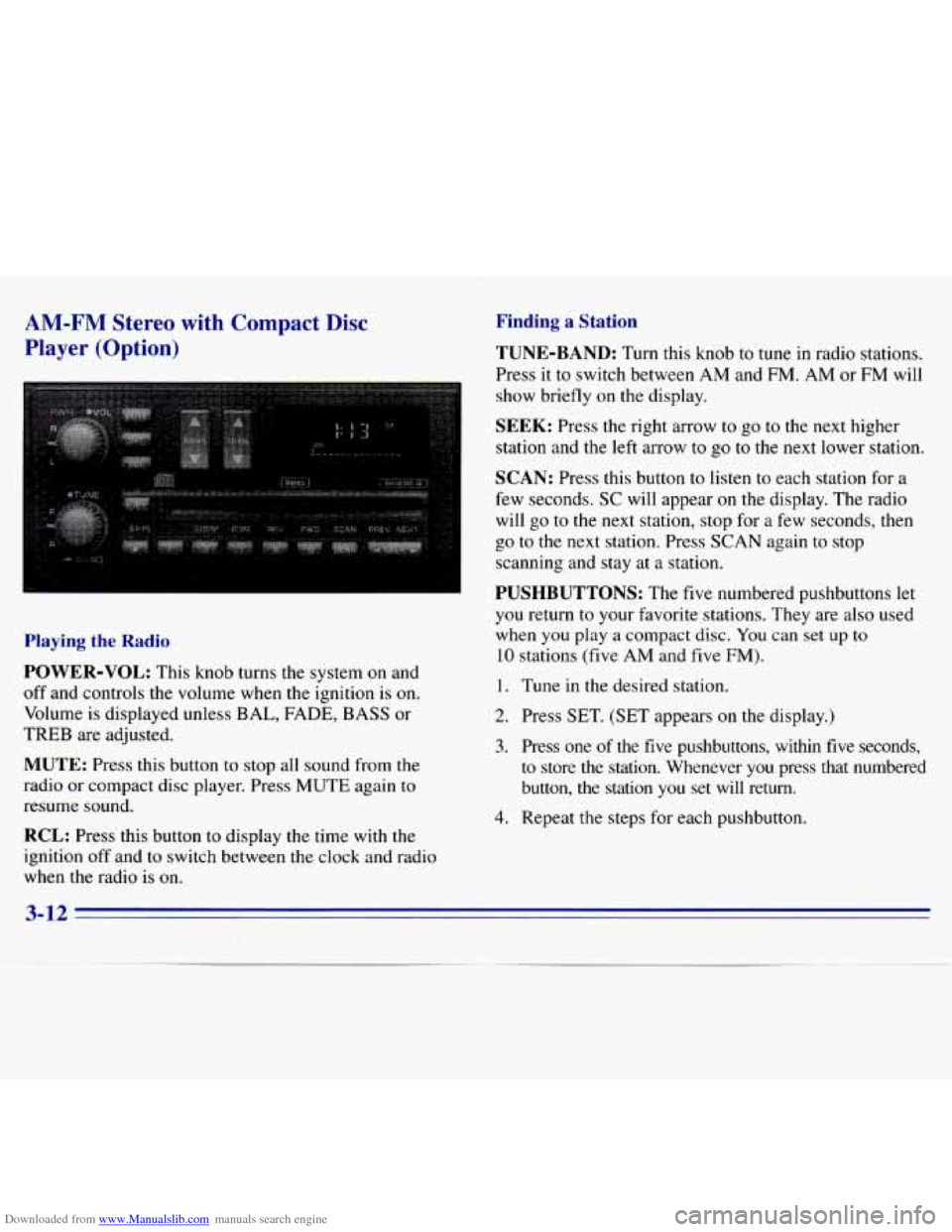
Downloaded from www.Manualslib.com manuals search engine AM-FM Stereo with Compact Disc
Player (Option)
Playing the Radio
POWER-VOL: This knob turns the system on and
off and controls the volume when the ignition is on.
Volume is displayed unless BAL, FADE, BASS or
TREB are adjusted.
MUTE: Press this button to stop all sound from the
radio or compact disc player. Press MUTE again to
resume sound.
RCL: Press this button to display the time with the
ignition off and
to switch between the clock and radio
when the radio is
on.
Finding a Station
TUNE-BAND: Turn this knob to tune in radio stations.
Press it to switch between
AM and FM. AM or FM will
show briefly on the display.
SEEK: Press the right arrow to go to the next higher
station and the
left arrow to go to the next lower station.
SCAN: Press this button to listen to each station for a
few seconds.
SC will appear on the display. The radio
will
go to the next station, stop for a few seconds, then
go to the next station. Press
SCAN again to stop
scanning and stay at
a station.
PUSHBUTTONS: The five numbered pushbuttons let
you return to your favorite stations. They are also used
when you play a compact disc. You can set up
to
10 stations (five AM and five FM).
1. Tune in the desired station.
2. Press SET. (SET appears on the display.)
3. Press one of the five pushbuttons, within five seconds,
to store
the station. Whenever you press that numbered
button, the station
you set will return.
4. Repeat the steps for each pushbutton.
3-12
Page 126 of 375

Downloaded from www.Manualslib.com manuals search engine Setting the Tone
BASS:
Press the BASS up arrow to increase bass and
the BASS down arrow to decrease bass. Press the center
of the button for the factory-preset bass position. The
bass
level will be displayed for about 10 seconds
whenever this button
is pressed.
TREB: Press the TREB up arrow to increase treble and
the TREB down arrow to decrease treble. Press the center
of the button for the factory-preset treble position. The
treble level will be displayed for about
10 seconds
whenever
this button is pressed.
Adjusting the Speakers
BAL:
This control ring behind the POWER-VOL knob
adjusts
the balance between the left and right speakers.
Balance
will be displayed briefly when using this control.
FADE: This control ring behind the TUNE knob adjusts
the balance between the front and rear speakers. Fade
levels will be briefly displayed.
Playing a Compact Disc
Insert a disc partway into the slot, label side up. The
radio will pull the disc the rest
of the way in. Wait a
few seconds and the disc should play.
If the disc comes back out and/or ERR appears on
the display:
0 You are driving on a very rough road. (The disc
should play when the road gets smoother.)
0 The disc is upside down.
0 It is dirty, scratched or wet.
0 It is very humid. (If so, wait about an hour and
try again.)
0 The disc player is too hot to play the disc. (As soon
as things get back to normal, the disc should play.)
Turn the POWER-VOL knob to turn the system on.
3-13
Page 127 of 375
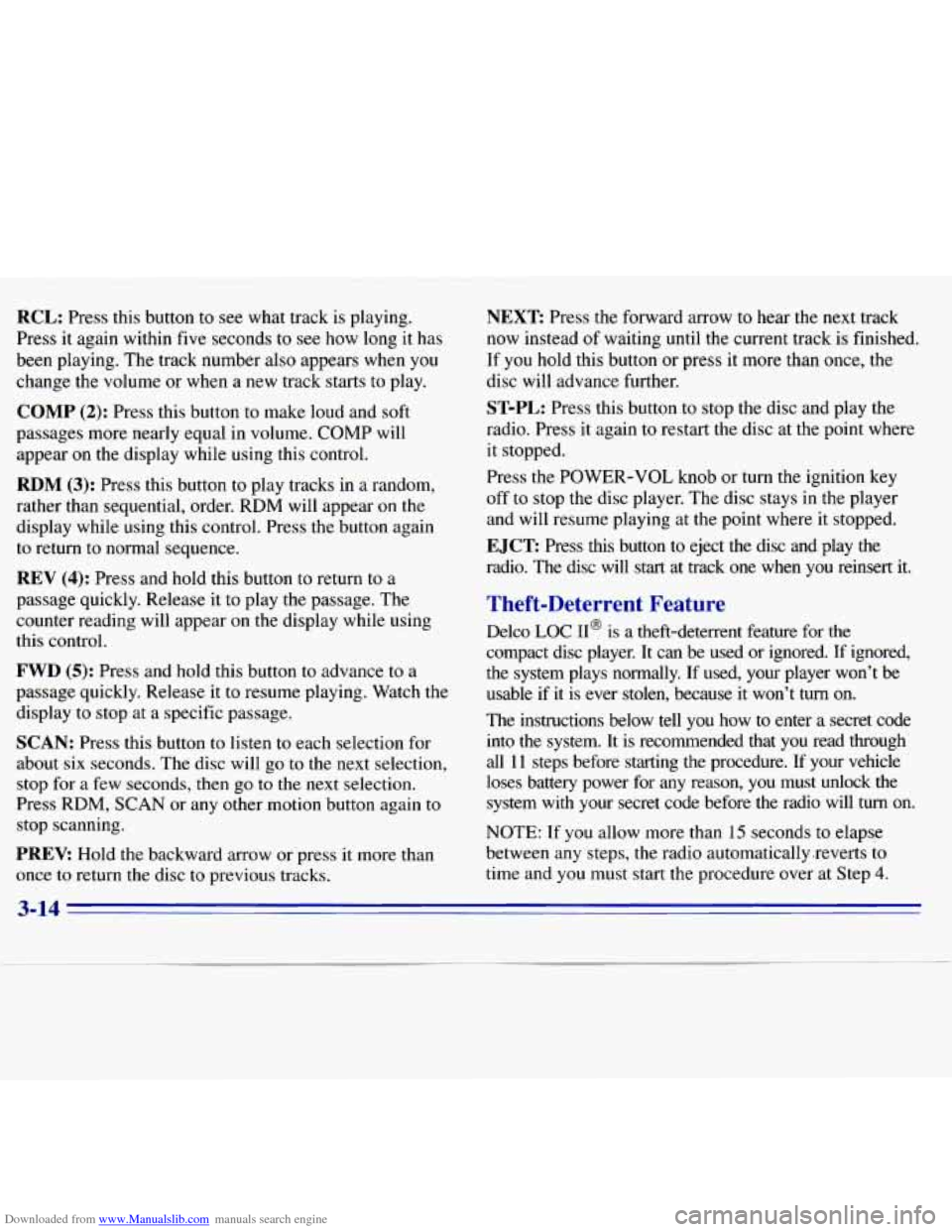
Downloaded from www.Manualslib.com manuals search engine RCL: Press this button to see what track is playing.
Press
it again within five seconds to see how long it has
been playing. The track number also appears when you
change the volume or when a new track starts to play.
COMP (2): Press this button to make loud and soft
passages more nearly equal in volume. COMP
will
appear on the display while using this control.
RDM (3): Press this button to play tracks in a random,
rather than sequential, order. RDM will appear on the
display while using this control. Press the button again
to return to normal sequence.
REV (4): Press and hold this button to return to a
passage quickly. Release
it to play the passage. The
counter reading will appear on
the display while using
this control.
FWD (5): Press and hold this button to advance to a
passage quickly. Release it to resume playing. Watch the
display
to stop at a specific passage.
SCAN: Press this button to listen to each selection for
about six seconds. The disc will go to the next selection,
stop for a few seconds, then go to the next selection.
Press
RDM, SCAN or any other motion button again to
stop scanning.
PREV: Hold the backward arrow or press it more than
once to return the disc to previous tracks.
NEXT Press the forward arrow to hear the next track
now instead of waiting
until the current track is finished.
If you hold this button or press it more than once, the
disc will advance further.
ST-PL: Press this button to stop the disc and play the
radio. Press
it again to restart the disc at the point where
it stopped.
Press the POWER-VOL knob or turn the ignition key
off to stop the disc player. The disc stays in the player
and will resume playing at the point where it stopped.
E JCT Press this button to eject the disc and play the
radio. The disc
will start at track one when you reinsert it.
Theft-Deterrent Feature
Delco LOC II@ is a theft-deterrent feature for the
compact disc player. It can be used or ignored.
If ignored,
the system plays normally. If used, your player won’t be
usable
if it is ever stolen, because it won’t turn on.
The instructions below tell you how to enter a secret code
into the system. It is recommended that you read through
all 11 steps before starting the procedure. If your vehicle
loses battery power for any reason, you must unlock the system with your secret code before the radio will
turn on.
NOTE: If you allow more than 15 seconds to elapse
between
any steps, the radio automatically .reverts to
time and you must start the procedure over at Step
4.
3-14
Page 128 of 375
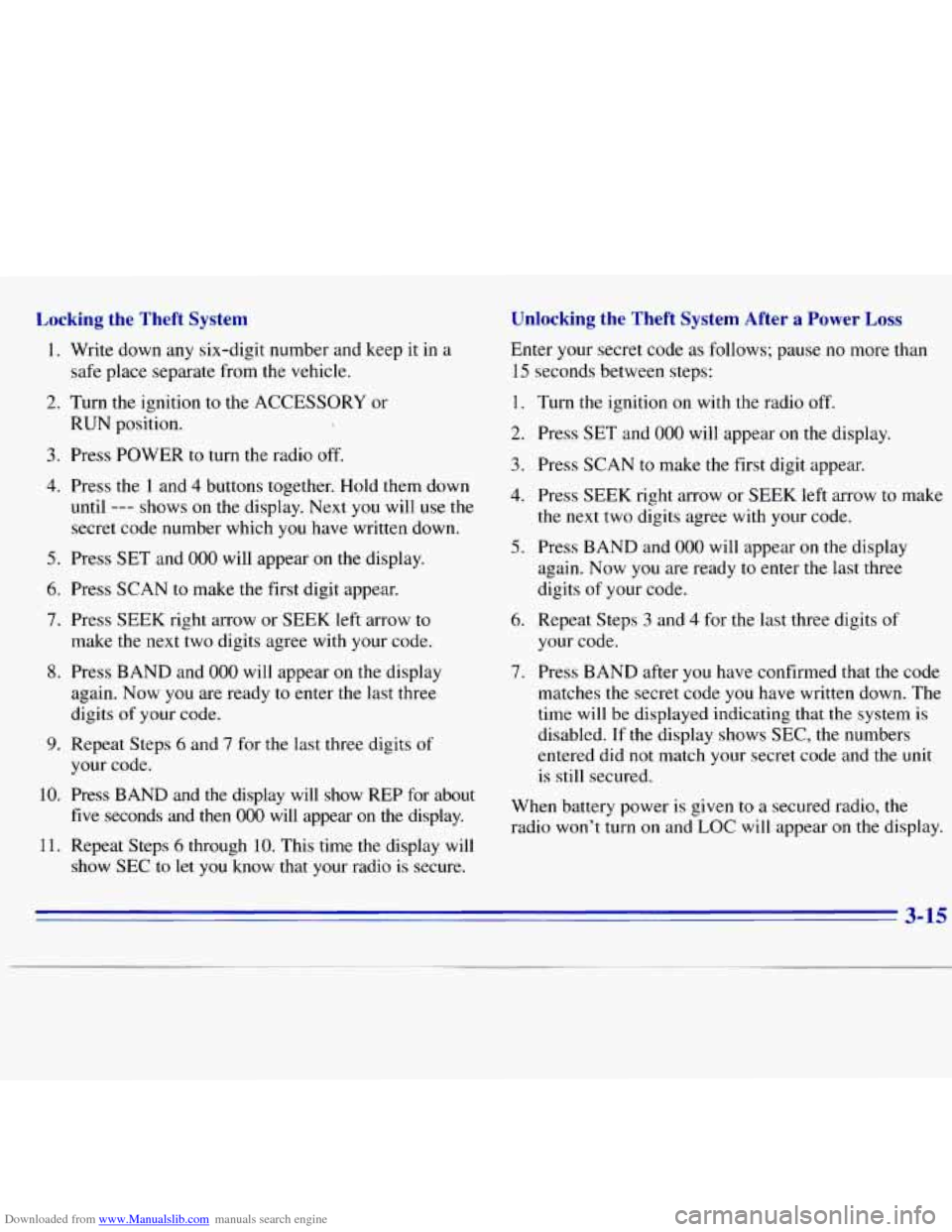
Downloaded from www.Manualslib.com manuals search engine Locking the Theft System
1.
2.
3.
4.
5.
6.
7.
8.
9.
10.
11. Write down
any six-digit number
and keep it in a
safe place separate from the vehicle.
Turn the ignition
to the ACCESSORY or
RUN position.
Press
POWER to turn the radio off.
Press the 1 and 4 buttons together. Hold them down
until
--- shows on the display. Next you will use the
secret code number which you have written down.
Press
SET and 000 will appear on the display.
Press SCAN
to make the first digit appear.
Press SEEK right arrow or SEEK left arrow
to
make the next two digits agree with your code.
Press BAND and
000 will appear on the display
again. Now you are ready
to enter the last three
digits of your code.
Repeat Steps
6 and 7 for the last three digits of
your code.
Press
BAND and the display will show REP for about
five seconds and then 000 will appear on the display.
Repeat Steps
6 through 10. This time the display will
show SEC to let you know that your radio
is secure.
Unlocking the Theft System After a Power Loss
Enter your secret code as follows; pause no more than
15 seconds between steps:
1. Turn the ignition on with the radio off.
2. Press SET and 000 will appear on the display.
3. Press SCAN to make the first digit appear.
4. Press SEEK right arrow or SEEK left arrow to make
the next two digits agree with your code.
5. Press BAND and 000 will appear on the display
again. Now you are ready to enter
the last three
digits
of your code.
6. Repeat Steps 3 and 4 for the last three digits of
7. Press BAND after you have confirmed that the code
matches the secret code you have written down. The
time will be displayed indicating that the system
is
disabled. If the display shows SEC, the numbers
entered did
not match your secret code and the unit
is
still secured.
your code.
When battery power is given
to a secured radio, the
radio won’t turn on and LOC will appear on the display.
3-15
Page 129 of 375
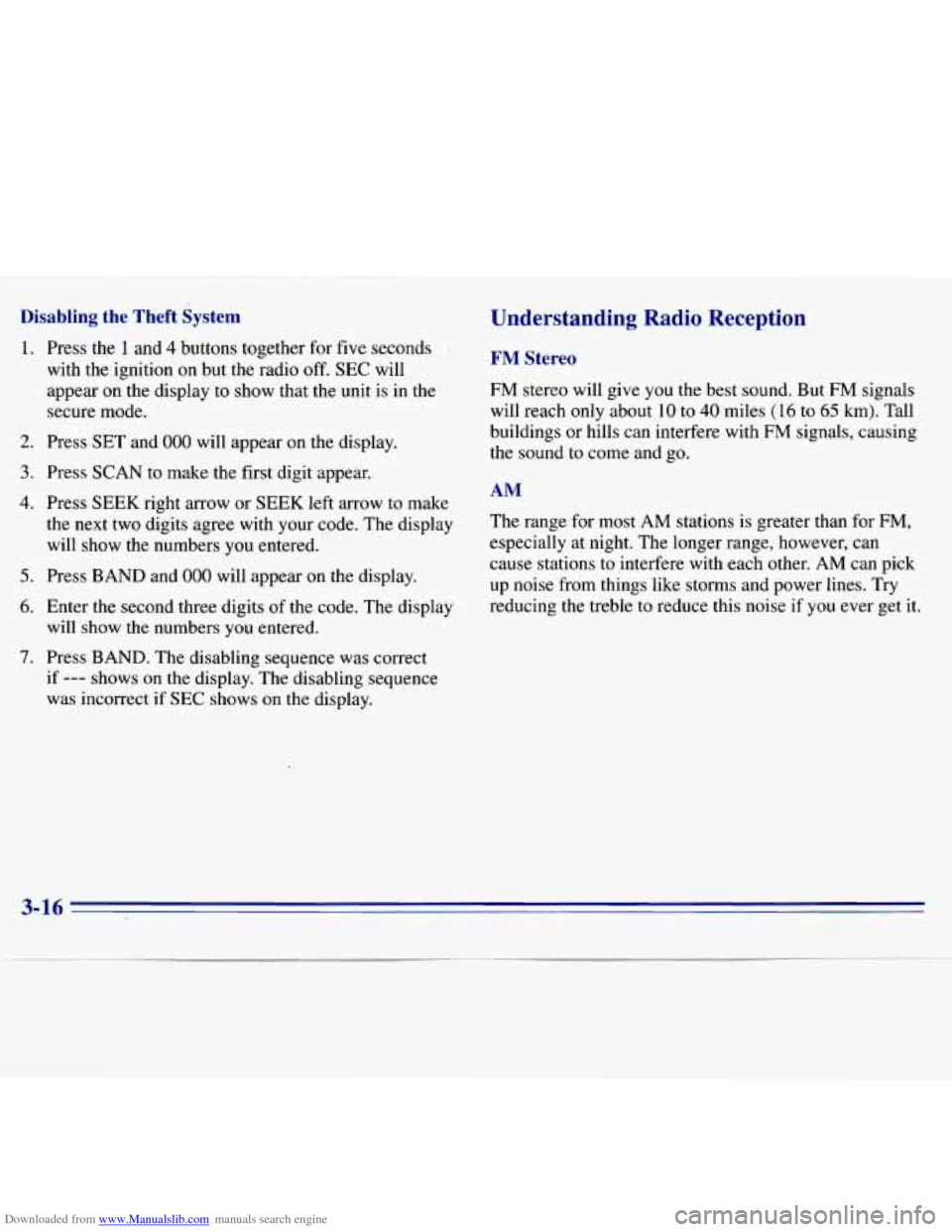
Downloaded from www.Manualslib.com manuals search engine Disabling the Theft System
1.
2.
3.
4.
5.
6.
7.
Press the 1 and 4 buttons together for five seconds
with the ignition on but the radio off.
SEC will
appear on the display to show that the unit is in the
secure mode.
Press SET and
000 will appear on the display.
Press
SCAN to make the first digit appear.
Press
SEEK right arrow or SEEK left arrow to make
the next two digits agree with your code. The display
will show the numbers you entered.
Press
BAND and 000 will appear on the display.
Enter the second three digits
of the code. The display
will show the numbers you entered.
Press
BAND. The disabling sequence was correct
if
--- shows on the display. The disabling sequence
was incorrect if
SEC shows on the display.
Understanding Radio Reception
FM Stereo
FM stereo will give you the best sound. But FM signals
will reach only about 10
to 40 miles ( 16 to 65 km). Tall
buildings or hills can interfere with FM signals, causing
the sound
to come and go.
AM
The range for most AM stations is greater than for FM,
especially at night. The longer range, however, can
cause stations
to interfere with each other. AM can pick
up noise from things like storms and power lines. Try
reducing the treble to reduce this noise if you ever get it.
3-16